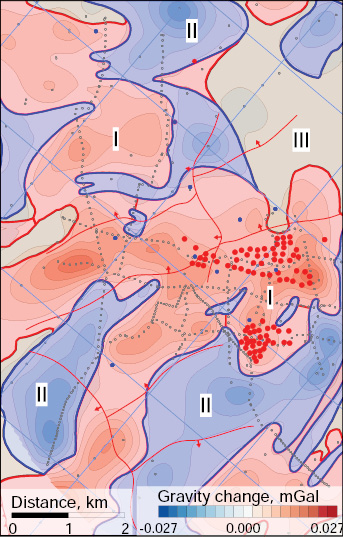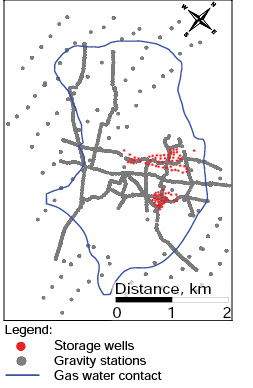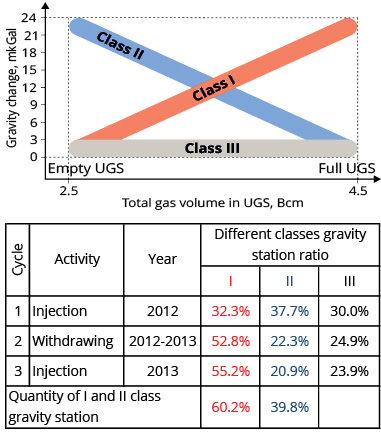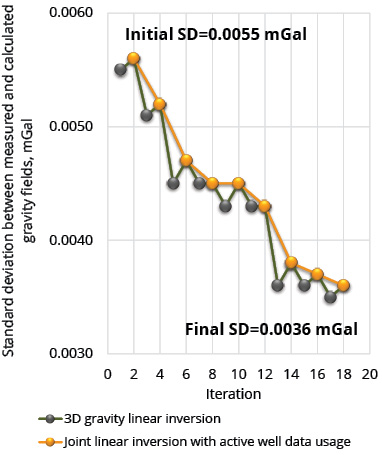 | 4D MODEL OF UNDERGROUND GAS STORAGE BY THE RESULTS OF HIGH-PRECISION TIME-LAPSE GRAVIMETRIC OBSERVATIONSDashava underground gas storage, Bilche-Volytsa zone of Pre-Carpathian Depression, Ukraine.
Time-lapse gravity survey period:
2012-2013. | | 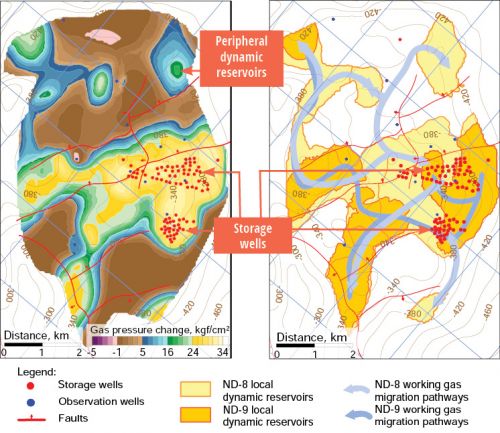
Figure 1. ND-8 gas pressure change (left). Location of dynamic pools and working gas pathways (right) |
GEOLOGICAL PROBLEM Dashava UGS was created in 1972 and comprises of 6 depleted pools of the Dashava gas field. The depleted gas pools belong to the two lower-Dashavian horizons (LD-8 and LD-9) of the Sarmatian interval of Neogene period. Reservoir depths range between 570-590 mTVD. Lithologically, pools are mainly represented by sandstones, with average porosity of 26.1% and gas saturation of 90%. Reservoir structure is an irregular-shaped brachyanticline with an effective reservoir thickness of 10-60 meters. Area of the UGS is 45,8 km2. Gas drive regime is in place, with a total of 100 storage wells 17 control wells operating across the Dashava UGS. Operational storage pressure range is 19,7-58,6 kgf/cm2. The total project gas volume is 5,34 Bcm, the project active gas volume is 2,15 Bcm.
| During 27 complete injection /withdrawal cycles continuously decreasing of gas pressure within pore space had been observed when total gas volume in place was equal. These occurred cushion gas volume increasing. The situation that has developed indicates a difficulty of the gas-hydrodynamic system of UGS and a constant attraction of additional reservoir volume to cyclic gas storage process. An absence of 3D models of porosity and permeability makes unpromising an application of dynamic modeling or reservoir simulation for the UGS reservoir system. Gravity was chosen for UGS property changing monitoring taking into account dependence between gas density and storage pressure. A time-lapse gravity survey was taken for finding reasons and location of cushion gas accumulation. | Figure 2.Gravity change caused by gas injection in UGS
| Figure 3. Location of stations with time lapse gravity measurement | MONITORING RESULTS
Results of time-lapse gravity measurements confirmed the presence of gravitational anomalies 12-24 mkGal which are related with gas volume change in UGS. Directly proportional dependence between gravity change and gas volume was observed on 60 % of stations. Inversely proportional dependence was observed on 40 % of stations. | Also, these 4D models allowed to calculate gas volume within dynamic pools, to map working gas migration pathways from storage wells to dynamic pools (Fig. 1). Blocking pathways of gas migration to dynamic pools was recommended for cushion gas accumulation congestion. |
Figure 4.Classification of gravity stations based on the dependence between UGS gas volume and gravity change | Figure 5. Iterational refining of 3D density model | MONITORING WORKFLOW Four seasons of time-lapse high precision gravity measurements were taken for two years. Two series were taken at empty UGS and two series were taken at full UGS (Fig.6). Twofold gravity measures were provided on 530 stations (Fig.3). The average standard deviation of gravity measurements was 4,3 mkGal. A gravity change map that was related to gas injection was built. For map building, all gravity measurements were divided into three classes (Fig.2). Class І - gravity field was changed proportionally with storage pressure change (red areas on Fig.2); Class ІI - gravity field was changed inversely proportionally with storage pressure change (blue areas on Fig.2); Class ІII - gravity field wasn`t changed after gas withdraw/injection (brown areas on Fig.2). The 3D model of Dashava UGS was created at the next stage. The 3D model should explain processes which take place in UGS. A structural framework of the 3D model was built using the results of 2D and 3D seismic data. Well logging and gas pressure measures in wells were used to define an initial 3D density model in depletion condition of Dashava UGS as of 2012.
| The 3D density model consists of 29,8 million cells (cell dimensions 100 x 100 x 1 m). Planar 3D model dimensions are 8 х 12 km. The depth interval of the 3D model is from 0 to 790 meters. The standard deviation between observed and calculated gravity fields for the initial 3D density model was 5,5 mkGal. The 3D density model was refined by a joint full-depth inversion of gravity and well data on a period when UGS was full of gas in 2013. The standard deviation for the completed UGS 3D density model was 3,6 mkGal (Fig. 5). A 3D density change model was transferred to a 3D gas pressure change model using dependencies between gas pressure change which was measured in wells and reservoir density change in the obtained 3D density change model. A 4D model of cushion and working gas distribution was calculated based on the obtained 4D gas pressure model. A relative misfit of gas pressure prediction in the 4D model was 3,7 % for empty UGS and 3,5 % for full UGS. A relative misfit of working gas volume prediction was 1.0 %.
| 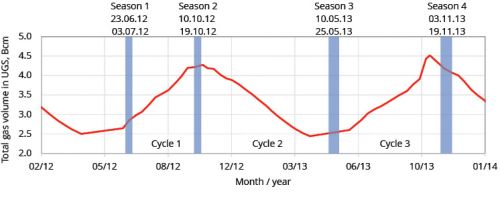 Figure 6. Gas drive regime is in place, with a total of 100 storage wells operating across the Dashava UGS | PUBLICATIONS 1. Петровський О.П., Федченко Т.О., Рига І.В., Суятінов В.М. Вплив на результати спостережень гравітаційного поля зміни рівня грунтових вод та атмосферних умов на прикладі території Дашавського підземного сховища газу. Геодинаміка. – В-во Львівської політехніки, 2013. - №2 (15) – С. 344-346. 2. Петровський О. П., Федченко Т. О., Трачук А. Ю. Геогустинні характеристики пластової системи підземного сховища газу на різних етапах експлуатації (на прикладі Дашавського підземного резервуару). Розвідка та розробка нафтових і газових родовищ, 2014-№3(52), - С. 198-211. 3. Petrovskyy O., Trachuk A. Gravitational monitoring for the exploitation of UGS – physical precondition, gravity anomalies and obstructive factor. SEG Technical Program Expanded Abstracts 2014: pp. 1345-1347. DOI http://dx.doi.org/10.1190
/segam2014-1172.1 | 4. Петровський О.П., Трачук А.Ю. Результати гравітаційного моніторингу на дашавському підземному сховищі газу. Матеріали наукової конференції-семінару "Сейсмологічні та геофізичні дослідження в сейсмоактивних регіонах", м.Львів, 3-5 червня 2014 р. – Львів: В-во "СПОЛОМ", 2014. – С. 209-212. 5. Петровський О.П., Трачук А.Ю., Петровська Т.О., Шимко Р.Я., Вечерік Р.Л. Оптимізація управління експлуатацією підземних сховищ газу на основі гравітаційного моніторингу на прикладі Дашавського ПСГ / створення динамічної геогустинної 4D моделі. Шоста міжнародна науково-практична конференція "Надрокористування в Україні. Перспективи інвестування" 7-11 жовтня 2019 року. 6. Petrovskyy O., Petrovska T., Trachuk A., Bojko R. Optimization of underground gas storages exploitation as result of time-lapse gravity measurements and 4D interpretation - case study of Dashava UGS. Geoinformatics 2021, 11-14 May 2021, Online Event. |
|




